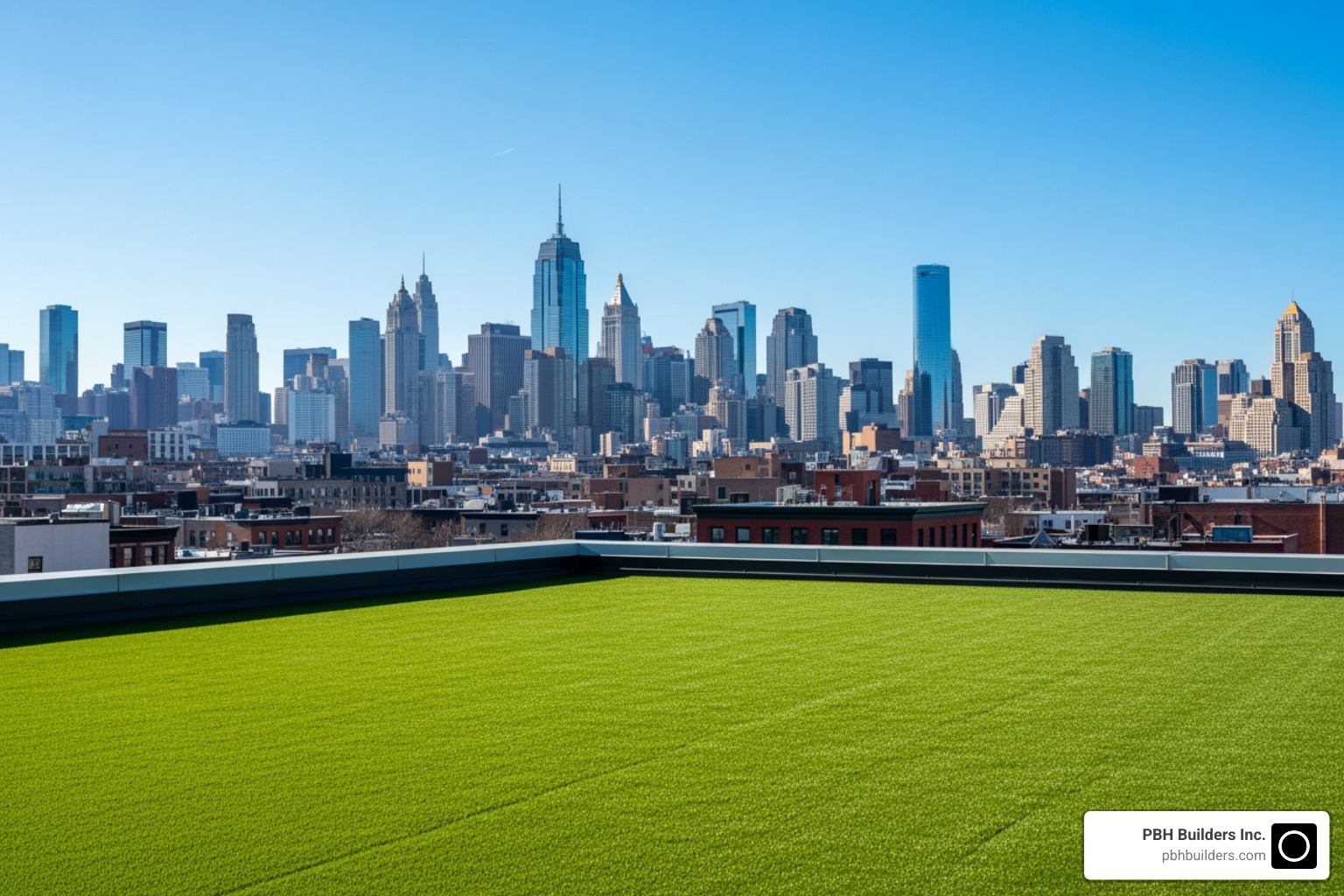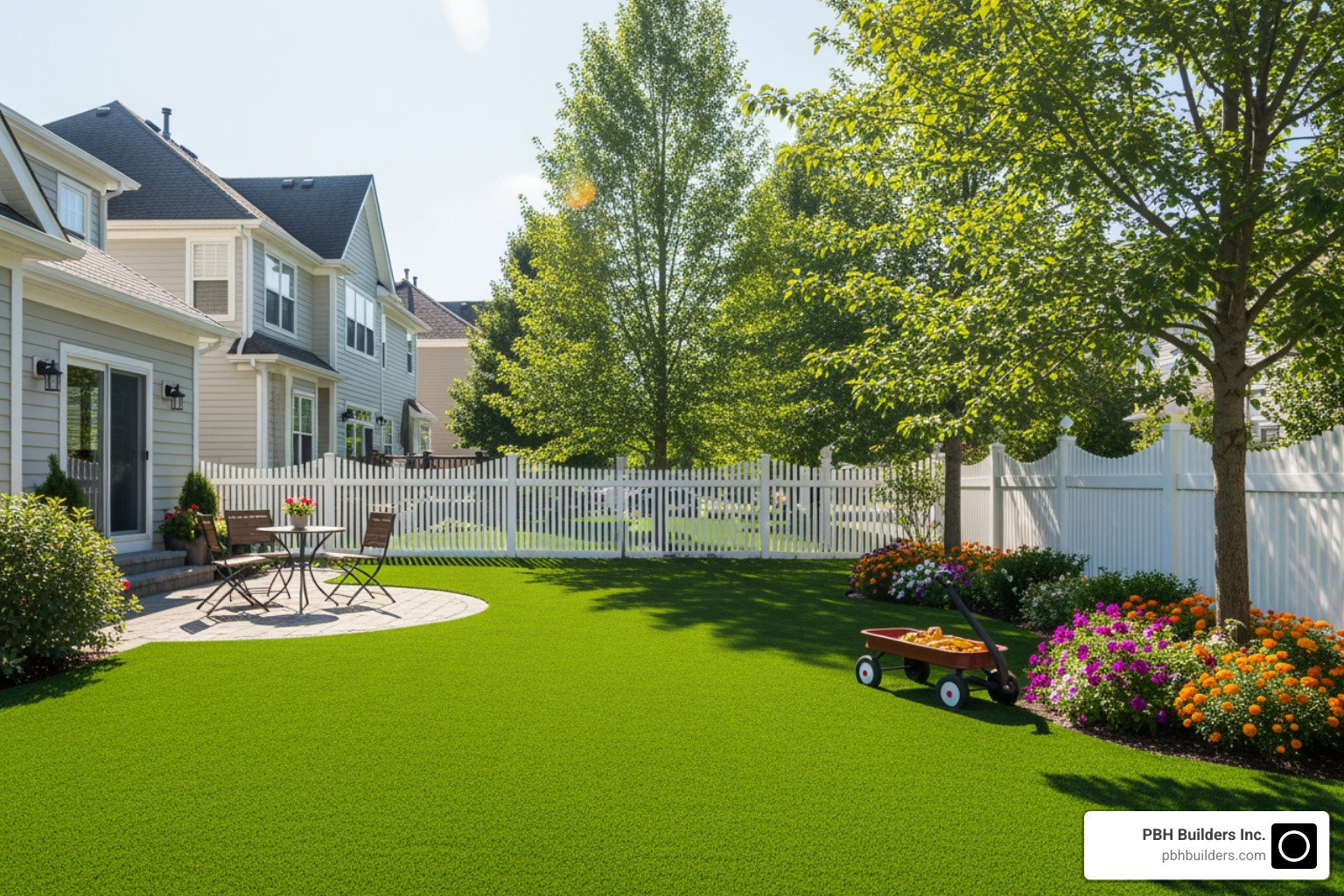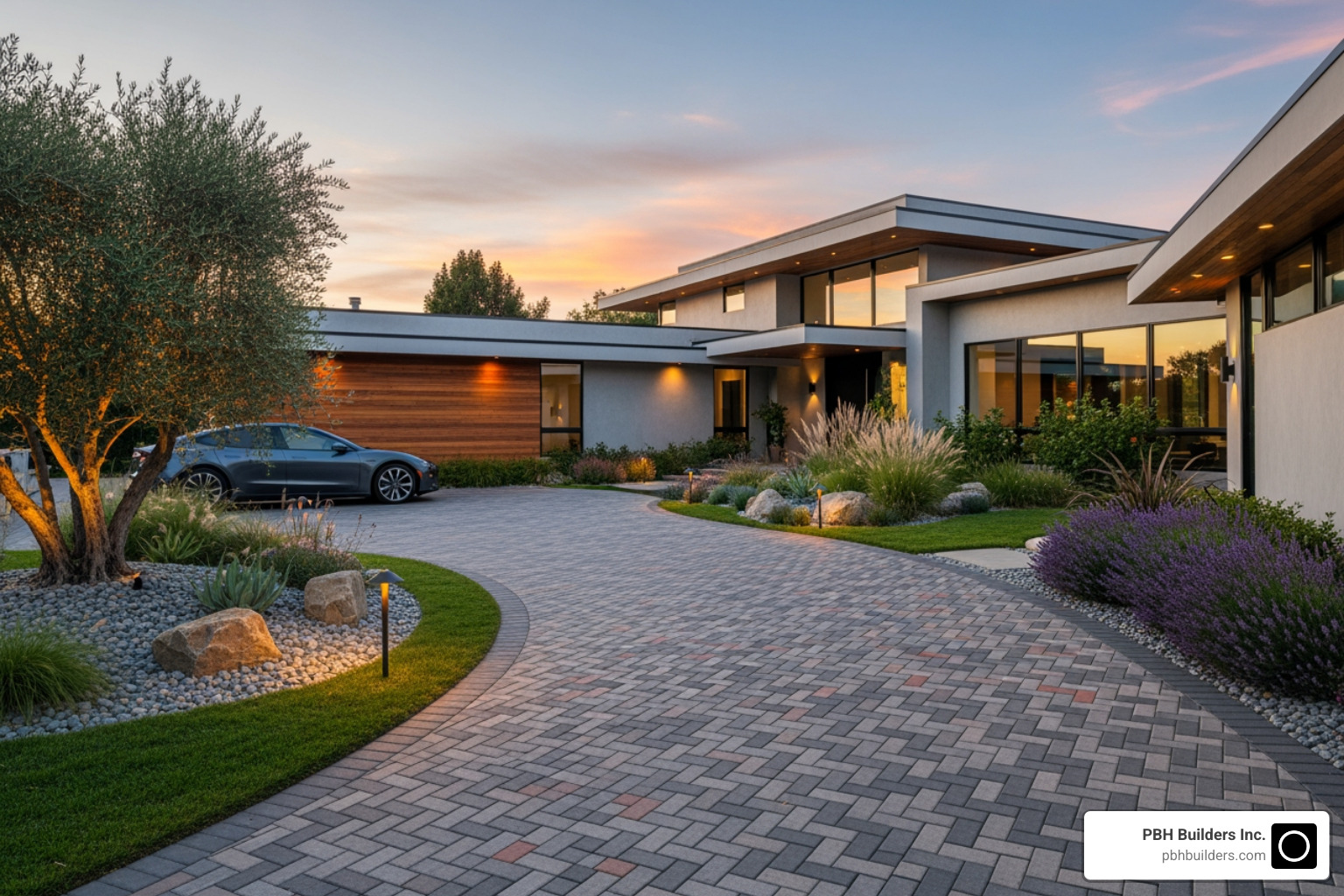Transform Your Rooftop with Artificial Grass
Yes, installing artificial grass on rooftop is absolutely feasible and can turn an underused space into a beautiful, low-maintenance urban oasis. Many homeowners in San Diego and beyond are embracing this trend.
However, for a successful and safe installation, you must consider a few key things:
- Structural Integrity: Your roof must support the weight of turf, infill, and people. A structural engineer’s assessment is vital.
- Drainage: Proper drainage is crucial to prevent water pooling and protect your roof’s health.
- Fire Safety: The turf must meet local fire codes, especially Class A ratings for commercial or multi-family buildings.
- Installation Expertise: Your installer must be experienced with rooftop challenges like wind uplift and proper securing.
Imagine a lush, green lawn high above the city, without the hassle of watering or mowing. Artificial grass makes this dream a reality, adding valuable, usable square footage to your home.
This guide will walk you through the benefits, pre-installation checks, installation process, and maintenance, helping you open up your rooftop’s full potential.
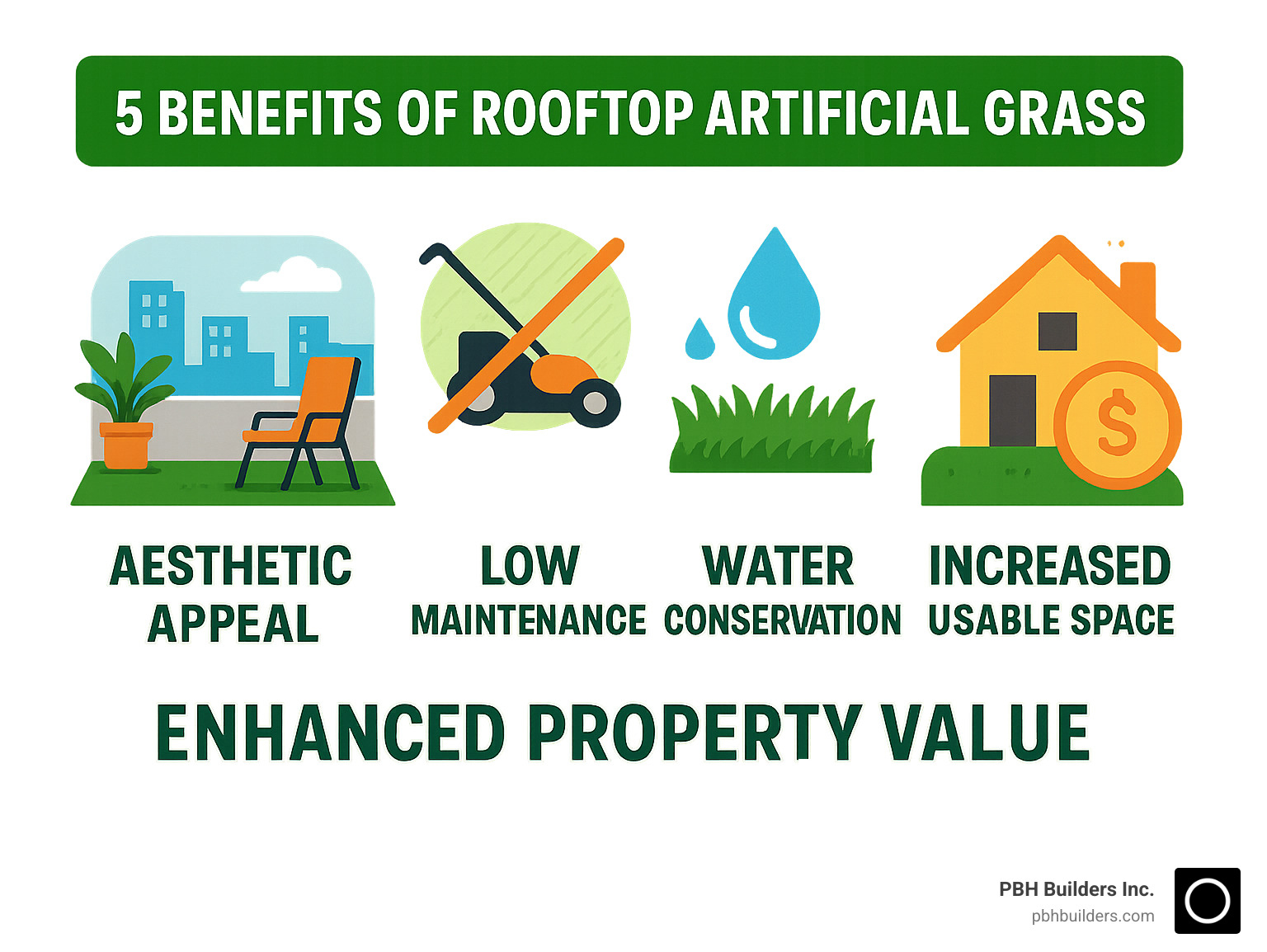
Why Choose Artificial Grass for Your Rooftop?
Imagine changing a boring, empty rooftop into a lush green lawn with stunning city views. Artificial grass on rooftop installations make this possible, turning forgotten spaces into something extraordinary.
The aesthetic appeal is a major draw. A drab concrete rooftop becomes a vibrant green oasis that looks perfect year-round, without brown patches or mud, making your property stand out. Beyond aesthetics, you gain usable living space. A bare rooftop can become a coffee spot, entertainment area, or a safe play space for kids and pets. As a bonus, artificial turf provides sound absorption, creating a quieter, more peaceful environment.
All of this adds up to increased property value. When potential buyers or tenants see a gorgeous rooftop lawn, they see a unique and luxurious amenity.
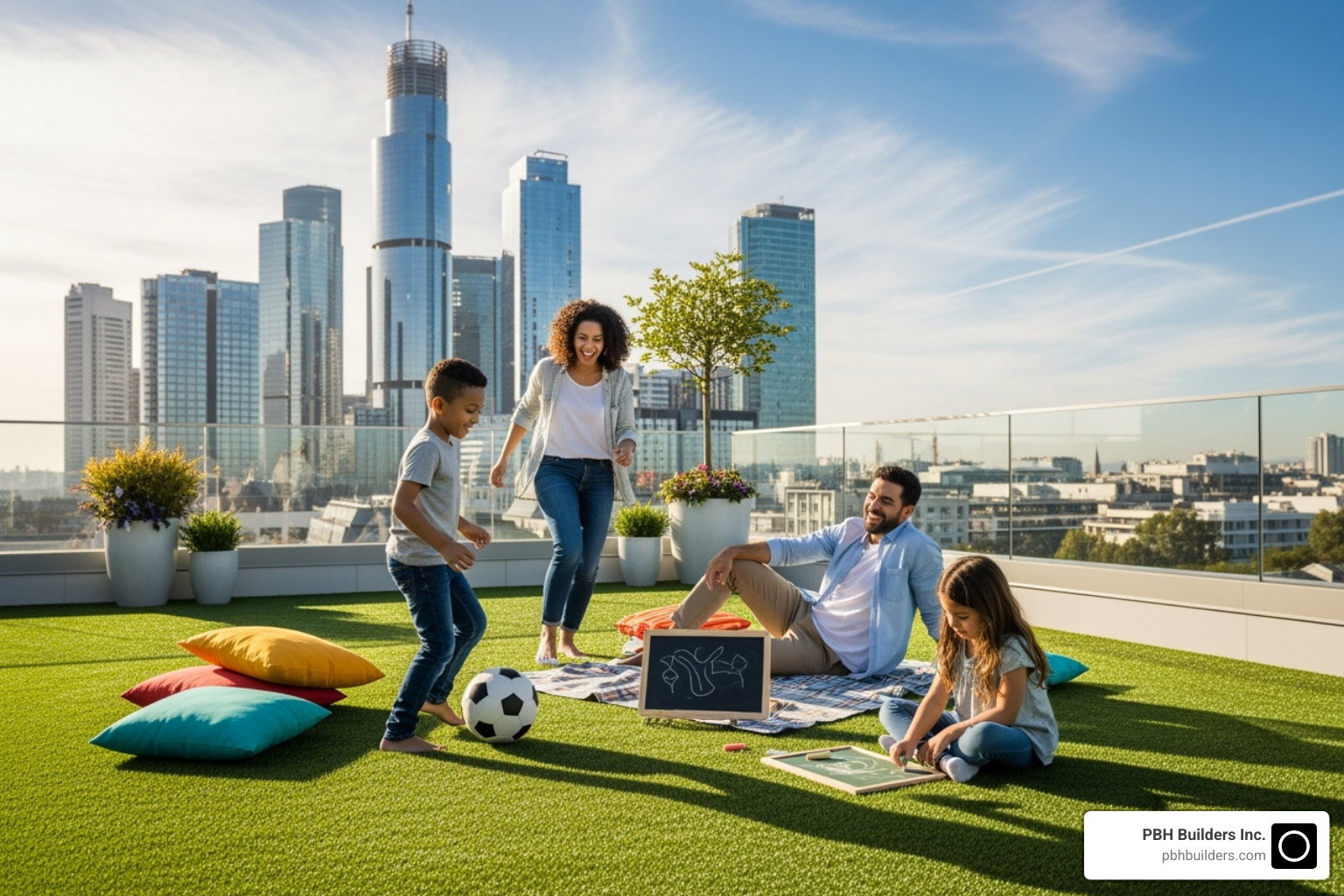
More info about our Outdoor Living Spaces
Enhancing Your Lifestyle and Property Value
An artificial grass on rooftop installation creates an urban oasis. Imagine hosting dinner parties on a private lawn or enjoying a quiet retreat from the city bustle. These green rooftops become natural social gathering spaces. Whether on a small balcony or a large terrace, you gain a welcoming outdoor room with a luxury feel.
The impact on your property value is significant. You’re adding premium square footage to your home or building. This kind of “roof” appeal makes your property memorable and desirable. For commercial buildings, a rooftop lawn is a major selling point for office tenants or restaurant customers.
The best part? Your artificial lawn stays perfect and usable year-round, unlike natural grass that goes dormant or gets muddy.
The Practical and Environmental Benefits of Artificial Grass on Rooftop
Practically, artificial turf is incredibly low maintenance. Forget mowing, weeding, fertilizing, or reseeding. Your main task will be an occasional rinse to remove dust.
The water conservation benefits are significant, especially in San Diego. Unlike traditional gardens, artificial grass needs no water to stay green, saving you money and helping the environment.
San Diego water conservation guidelines
Your rooftop also becomes pest and allergen-free. No more grass stains, muddy footprints, or seasonal allergies from grass pollen. It’s a cleaner, more comfortable environment for everyone.
The durability of modern artificial turf is impressive. It’s designed to handle the intense UV exposure and temperature swings of a rooftop, with quality products lasting 15-20 years. The turf system can even provide an insulation and energy efficiency bonus, potentially reducing your building’s heating and cooling costs.
Critical Feasibility Checks Before You Install
Before installing artificial grass on a rooftop, several critical checks are necessary. These steps act as a safety net, preventing costly repairs and potential disasters. Taking shortcuts here often leads to problems later.
The biggest question is whether your roof can handle the extra weight of the turf, infill, drainage systems, and people. Then there’s drainage, which is crucial; water that doesn’t drain properly can cause leaks, mold, and structural damage. Finally, safety regulations like fire ratings and wind resistance are there for a reason—they can be life-savers.
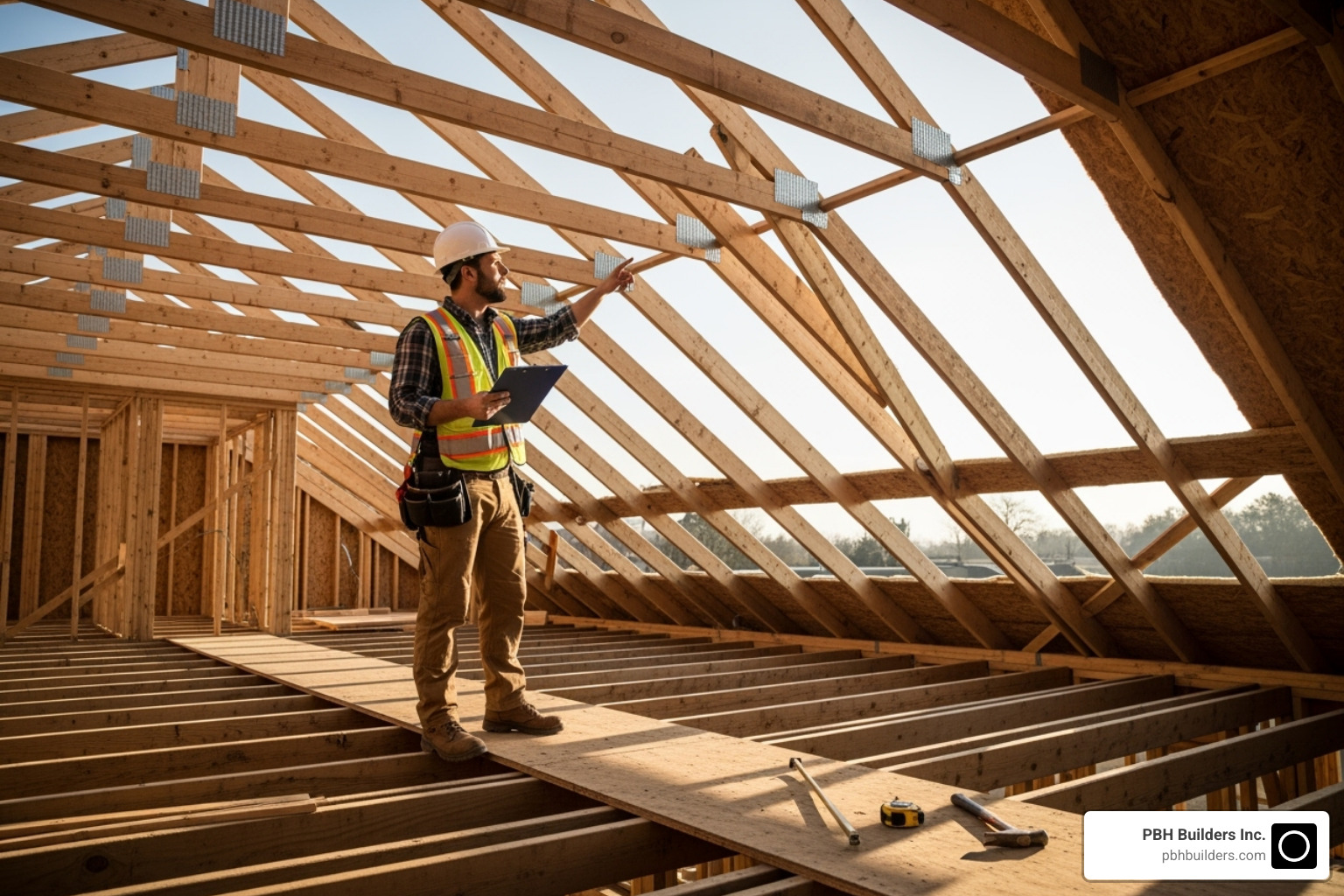
More info about our Projects Category for Retaining Walls
Structural Integrity and Weight Load
Your roof may not be ready for an artificial grass on rooftop installation without a professional evaluation. We insist on consulting a qualified structural engineer, as guessing about weight limits is too risky.
When calculating the total load, we consider everything: the turf, infill (which can be up to 5 pounds per square foot for ballast), drainage components, and furniture. While artificial turf is lighter than real sod, the complete system adds significant weight.
We also account for water retention during heavy rainfall. The system can temporarily hold a large volume of water, adding substantial weight that must be factored into the load calculation. A structural engineer will assess your roof’s capacity and determine if reinforcement is needed, ensuring long-term safety.
Essential Drainage and Waterproofing
Drainage is critical for any artificial grass on rooftop project. Without a proper escape route, standing water can lead to leaks, mold, and expensive structural damage. The key is to protect your existing roof membrane while ensuring water flows away efficiently.
Before installation, we examine your roof’s existing slope and drainage points. Most roofs need additional drainage layers for an artificial turf system to work correctly. Modern solutions like drainage grids create an air gap beneath the turf, allowing water to flow rapidly to existing drains. Others use specialized foam or perforated tiles to create water pathways.
The goal is simple: water should never pool beneath your turf. A proper system keeps your roof membrane dry and your building structure safe. Our experience with hardscaping and drainage gives us valuable insight into designing robust rooftop systems custom to your specific roof.
More info about our Pavers and Driveway Work in Santee CA
Safety, Fire Ratings, and Potential Challenges
Safety is non-negotiable for artificial grass on rooftop installations. Key concerns include fire safety, wind resistance, and other potential challenges.
Fire safety is paramount on rooftops. We only recommend turf products that meet strict fire safety standards. The best options have Class A Fire Ratings, which meet ASTM E108 standards and are the safest choice for commercial and multi-family buildings. We ensure all installations comply with local fire codes.
ASTM E-108 fire test standards
Wind uplift prevention is another critical concern, as improperly secured turf can be dangerous. Infill provides ballast weight, and we use professional securing methods like specialized adhesives or nailer boards to anchor the turf securely.
Heat absorption is another factor. Artificial grass can get warm in direct sunlight, an effect that is more pronounced on rooftops. We will cover mitigation strategies later in this guide.
Sun magnification from nearby windows is a hidden challenge. Reflective windows can act like a magnifying glass, potentially melting turf. We assess this risk and recommend solutions like strategic placement or using heat-resistant materials.
The Anatomy of a Rooftop Artificial Grass System
An artificial grass on rooftop installation is a multi-layered system, not just a piece of turf. Each layer has a specific purpose, working together to handle wind, rain, heat, and foot traffic while looking beautiful. The system has three main components: the turf material, the underlayment for drainage and cushioning, and the infill for stability.
Each component must be tough enough for harsh rooftop conditions, including intense UV rays, wind, and rain. Our landscape design expertise helps us select the right combination of materials for your specific rooftop and intended use.
More info about our Landscape Design services
Choosing the Best Types of Artificial Grass for Rooftop Applications
For artificial grass on rooftop installations, the choice of material matters. The three main options are polyethylene, polypropylene, and nylon, each with distinct characteristics.
| Feature | Polyethylene | Polypropylene | Nylon |
|---|---|---|---|
| Durability | Good balance of softness and durability | Less durable, lower melting point | Most durable, can withstand severe temperatures |
| Texture | Soft, common favorite for realistic feel | Tough, good for high foot traffic | Very stiff, not ideal for barefoot walking |
| Cost | Mid-range | Cheapest | Most expensive |
| UV Resistance | Good (ensure specific product has high rating) | Lower (less suitable for high sun exposure) | Excellent |
| Pile Height | Various, good for diverse uses | Often shorter, denser | Can be shorter, very dense |
| Permeable Backing | Often available, recommended for rooftops | Often available | Often available |
Polyethylene is our top choice for most rooftops. It offers a great balance of realistic looks, comfort, and durability, feeling soft underfoot.
Nylon is the most durable option, ideal for high-traffic commercial areas due to its resilience to heavy use and extreme temperatures. However, it is stiffer and more expensive.
Polypropylene is a budget-friendly material, but we rarely recommend it for rooftops due to its lower melting point, which makes it less suitable for intense sun exposure.
Regardless of the material, we always insist on products with high UV resistance and a permeable backing to prevent fading and ensure proper drainage.
Essential Underlayers and Infill
The unseen underlayment is the foundation of a successful artificial grass on rooftop system. It manages drainage, protects the roof, and provides comfort.
We always begin with a protective layer directly on the roof membrane to prevent punctures and costly repairs. The drainage layer is next. AirDrain is a preferred drainage grid made from recycled materials that creates a 1-inch air gap for excellent water flow, supports immense weight, and can contribute to LEED certification. Other options include TurfCloud Flow with built-in channels or perforated tiles.
For play areas or added comfort, shock pads provide extra cushioning, creating a softer and safer surface. Finally, infill granules are spread between the grass blades. Silica sand adds weight to prevent wind uplift and helps the blades stand upright. For pet areas, we recommend antibacterial infill like Envirofill or PureZEO Pro to control odors. A rooftop installation may require up to 5 pounds of infill per square foot for ballast, highlighting the importance of the initial structural assessment.
The Installation Process for Artificial Grass on Rooftop
Installing artificial grass on a rooftop is more complex than a backyard project. While DIY is tempting, the unique challenges of weight distribution, drainage, and wind uplift can lead to costly mistakes if not handled by professionals. We’ve seen homeowners run into trouble with pooling water or shifting turf, which is why we recommend hiring a team that understands the intricacies of rooftop work.
Our process involves preparing the roof surface, installing protective and drainage layers, securing the turf, and applying infill. Each step is critical, and cutting corners can lead to future problems. Once properly installed, your artificial grass on rooftop will transform your space into something special.
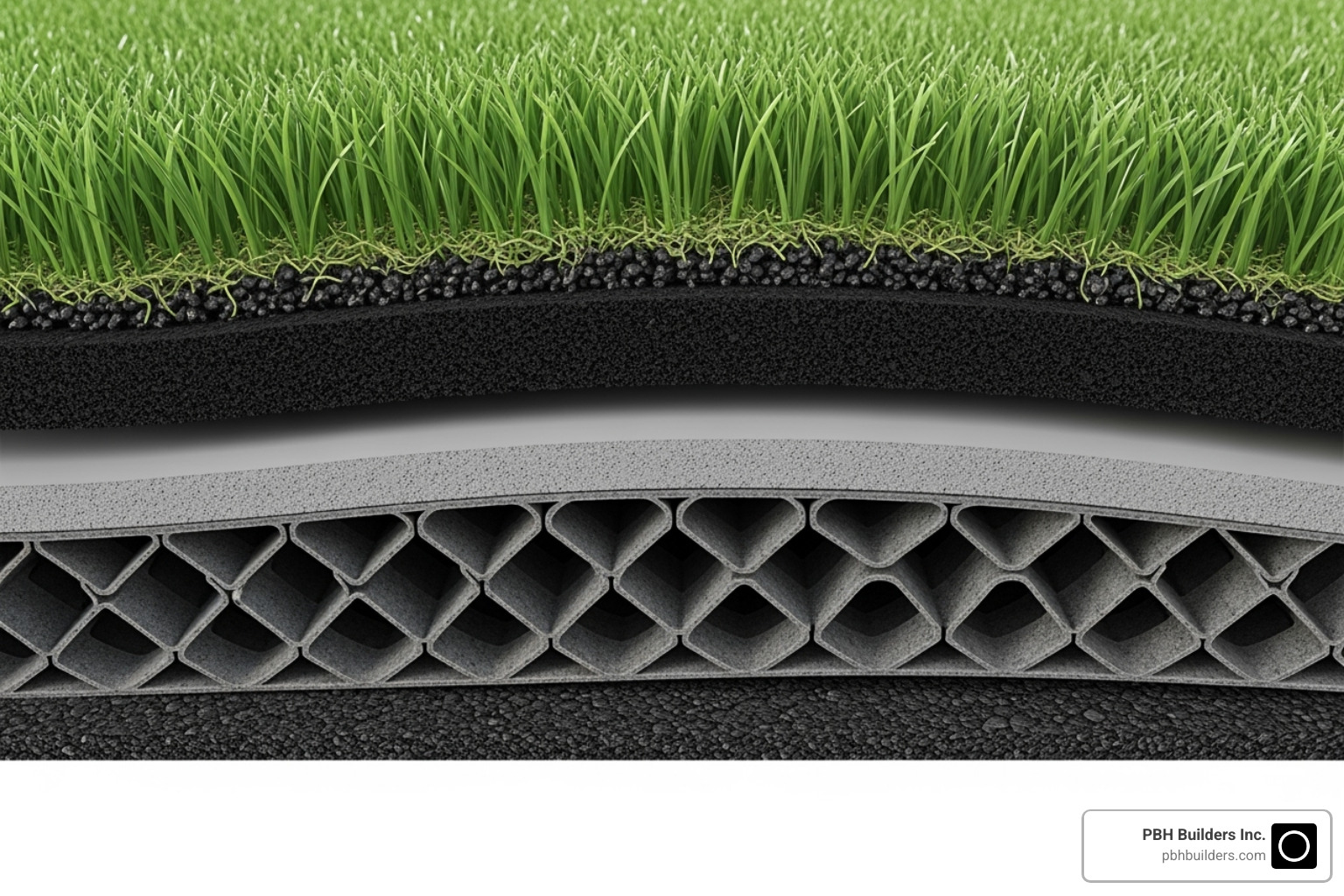
A Step-by-Step Installation Guide
Proper artificial grass on rooftop installation follows a proven process. Here’s how we approach each project:
- Surface Cleaning and Preparation: First, we thoroughly clean the roof surface and inspect the waterproofing membrane for any damage, which is repaired before proceeding. A protective layer is then laid down to shield the membrane.
- Installing the Drainage Layer: Next, we install a specialized drainage layer, like AirDrain grids. This creates channels for water to flow freely to existing drains, a critical step that requires professional expertise.
- Securing the Turf: To avoid puncturing the roof membrane, we secure the turf using professional-grade adhesives around the perimeter and seams. For borders, we may use nailer boards. The primary goal is to prevent wind uplift.
- Seaming Turf Sections: When multiple rolls of turf are needed, we join the edges with specialized seaming tape and adhesive to create a seamless, natural look.
- Applying and Distributing Infill: We evenly spread the chosen infill (silica sand, antibacterial infill, etc.) across the turf. This adds necessary ballast weight and helps the grass blades stand upright.
- Final Brushing: We use a power broom to brush the infill into the turf and lift the blades, giving the installation a lush, professional finish.
Long-Term Care and Creative Rooftop Ideas
While your artificial grass on rooftop is low-maintenance, some regular care will keep it looking great.
- Debris Removal: Rooftops collect more wind-blown debris, so frequent cleaning with a leaf blower, broom, or plastic rake is recommended.
- Rinsing: Periodically rinsing the turf removes dust and pollen and can help cool the surface on hot days.
- Brushing: Occasional brushing with a stiff broom keeps the grass blades upright.
- Inspecting: Regularly check for drainage blockages and inspect seams and edges for any lifting, especially after windy conditions.
Now for the fun part: creative uses for your new space! Rooftop putting greens are popular, though they require careful planning for cup installation. Play areas are perfect on the soft, clean surface. Pet relief areas are a great solution for urban pet owners. You can even use turf on accent walls for a striking visual effect.
We also love combining artificial grass with other materials like pavers to create defined zones for dining, lounging, or entertainment. Our hardscaping expertise allows us to integrate these elements for a cohesive and beautiful outdoor living space.
More info about our Paver Projects
Frequently Asked Questions about Rooftop Turf
We hear these questions all the time when homeowners are considering artificial grass on rooftop installations. Let’s explore the most common concerns and give you the straight answers you need.
How much does artificial grass on a rooftop cost?
The cost of an artificial grass on rooftop project depends on several factors, as rooftop installations are more complex than ground-level ones. We provide detailed quotes after a site assessment.
Key cost factors include:
- Turf Quality: Higher-end materials cost more but offer better durability and a more realistic look.
- Roof Size and Accessibility: Large or hard-to-access roofs may increase labor costs.
- Drainage System: Advanced drainage systems are an investment in your roof’s long-term health.
- Specialized Infill: Options like antibacterial or cooling infills cost more than standard silica sand.
- Structural Assessment: An engineer’s assessment is an essential upfront safety cost.
Compared to other options like decking or living roofs, artificial turf offers excellent long-term value through increased property value, potential energy savings, and no water or maintenance costs.
Can artificial grass damage my roof?
When installed properly, artificial grass on a rooftop will not damage your roof; it can even offer protection from UV rays and weather. The key is proper installation.
The biggest risks come from improper work. Puncturing the waterproof membrane by using nails or screws can cause leaks. That’s why we use professional-grade adhesives and non-penetrating securing methods.
Improper drainage is another serious concern. If water pools beneath the turf, it can degrade the roof membrane and lead to mold and leaks. A robust drainage system is essential, not optional.
Finally, the system’s weight must be accounted for. A structural engineer’s assessment ensures your roof can handle the load. Professional installation by a team that understands these risks is the best way to protect your investment.
How hot does artificial grass get on a roof?
Artificial grass on a rooftop can get warmer than natural grass in direct sunlight, as synthetic materials absorb heat. However, this is manageable and shouldn’t deter you.
There are several effective ways to keep the surface comfortable:
- Lighter Turf Colors: Lighter shades of green reflect more sunlight and absorb less heat.
- Cooling Infill: Specialized infills are available that are designed to regulate temperature.
- Occasional Rinsing: A quick spray with water instantly cools the surface.
- Shade Structures: Pergolas, awnings, or shade sails can significantly reduce direct sun exposure.
- Heat-Resistant Turf: Some products are specifically designed with technology to resist heat buildup.
By planning ahead and choosing the right materials, your rooftop turf can be comfortable and enjoyable even during San Diego’s warmer months.
Conclusion
Changing your rooftop with artificial grass is about open uping the full potential of an underused space. This smart upgrade can create a stunning urban oasis, adding value to your property and enhancing your lifestyle.
The benefits are clear: you get year-round aesthetic appeal, valuable usable living space, and a low-maintenance lawn that requires no mowing or watering. From an investment standpoint, you benefit from water conservation, increased property value, and a durable, pest-resistant surface that will last for years.
Success, however, depends on getting it right from the start. Structural assessments, proper drainage, and adherence to safety standards are non-negotiable. Understanding the complete system—from turf materials to infill—is crucial to avoid costly mistakes and ensure a beautiful, lasting installation.
This is where professional expertise becomes invaluable. At PBH Builders Inc., we bring years of landscape design and hardscaping experience to every rooftop project. We understand that every roof is unique, and our meticulous attention to detail ensures your change is not only beautiful but also safe, functional, and built to last.
Whether you’re envisioning a peaceful retreat, an entertainment space, or a rooftop putting green, we’re here to make it happen. Your rooftop has incredible potential—let’s open up it together.
